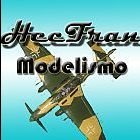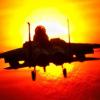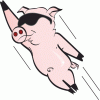-
Posts
20 -
Joined
-
Last visited
About hecfran
- Birthday 03/03/1961
Contact Methods
-
Website URL
https://hectorfrancovig.com/modelismo
Profile Information
-
Gender
Male
-
Location
Argentina
-
Interests
Modeller, Chess, Draw
Recent Profile Visitors
335 profile views
hecfran's Achievements

Newbie (1/9)
35
Reputation
-
hecfran started following Tim's He111 Russian Front build , HMS Victory Revell 1:225 , HMS Victory 1:225 Revell and 2 others
-
Finish
-
With the addition of the sails, the actual work of the ship is finished. The cordelerías remain as a complement.
-
Mounting the masts on the hull and adding rigging
-
After a few days of the last post, I upload the advances of this boat The anchors and the beginning of work with the masts
-
Today looks like this, a lot work in future, especially when the moment of the sails will arrive. If you would see moore details: https://hectorfrancovig.com/modelismo/taller/HMS-Victory.html
-
Some more steps
-
Hello people, today I show you a model that I started a long time ago, then I left something abandoned and now back to the "shipyards" I share some steps.
-

Messerschmitt BF 109-G - Hobby Craft 1:48
hecfran replied to hecfran's topic in Ready for Inspection - Aircraft
Thanks friends! The scheme of colours is using in African Front. -
The Messerschmitt Bf 109, was a German World War II fighter aircraft that was the backbone of the Luftwaffe's fighter force. The Bf 109 first saw operational service during the Spanish Civil War (1939) and was still in service at the dawn of the jet age at the end of World War II (1945). It was one of the most advanced fighters of the era, including such features as all-metal monocoque construction, a closed canopy, and retractable landing gear. It was powered by a liquid-cooled, inverted-V12 aero engine. From the end of 1941, the Bf 109 was steadily being supplemented by the superior Focke-Wulf Fw 190. It was commonly called the Me 109 most often by Allied aircrew and even amongst the German aces themselves, even though this was not the official German designation. The "Bf 109" designation was issued by the German ministry of aviation and represents the developing company Bayerische Flugzeugwerke and is a rather arbitrary figure. It was designed by Willy Messerschmitt (hence Me 109) and Robert Lusser, who worked at Bayerische Flugzeugwerke, during the early to mid-1930s. Originally conceived as an interceptor, later models were developed to fulfill multiple tasks, serving as bomber escort, fighter-bomber, day-, night-, all-weather fighter, ground-attack aircraft, and as reconnaissance aircraft. It was supplied to and operated by several states during World War II, and served with several countries for many years after the war. The Bf 109 was the most produced fighter aircraft in history, with a total of 33,984 airframes produced from 1936 up to April 1945. The G series, or "Gustav", was introduced in mid-1942. Its initial variants (G-1 through G-4) differed only in minor details from the Bf 109F, most notably in the more powerful 1475 PS (1,455 HP) DB 605 engine. Odd numbered variants were built as high-altitude fighters with a pressurized cockpit and GM-1 boost, while even numbered variants were non-pressurized, air superiority fighters and fighter-bombers. Long-range photo-reconnaissance variants also existed. The later G series (G-5 through G-14) was produced in a multitude of variants, with uprated armament and provision for kits of pre-packaged, generally factory- installed parts known as Umrüst-Bausätze (usually contracted to Umbau) and adding a "/U" suffix to the aircraft designation when installed. Field kits known as Rüstsätze were also available for the G-series but those did not change the aircraft designation. By early 1944 tactical requirements resulted in the addition of MW-50 water injection boost and high-performance superchargers, boosting engine output to 1,800–2,000 PS (1,775-1,973 HP) See Process
-
Steve thank you very much !! I did Imagine that was related to the decals, but you given me reasons I didn´t know. Thanks again!!!
-
My question may be silly, but I've seen almost everywhere that the sequence is: painting> SHINY varnish> Calcas> SHINY varnish> paneling> Varnish Matte, satin or gloss (whichever is applicable) Why that should be bright and not matte the varnish in the early stages if the final hand will shine or matte final? Again, maybe my question is elementary, but experts here know me answer. Thank you!
-

Tim's He111 Russian Front build
hecfran replied to theplasticsurgeon's topic in The Great Patriotic War Group Build
Excellent work. I love this plane, it will be my next job ... -
Thanks very much!
-

FU4 1D CORSAIR - Academy - 1:48
hecfran replied to hecfran's topic in Ready for Inspection - Aircraft
The kit is the academy manufacturer and plane colors belong to the Major Gregory Boyington in front of the Pacific -
Another model 8-10 years Review: The Vought F4U Corsair is an American fighter aircraft that saw service primarily in World War II and the Korean War. Demand for the aircraft soon overwhelmed Vought's manufacturing capability, resulting in production by Goodyear and Brewster: Goodyear-built Corsairs were designated FG and Brewster-built aircraft F3A. From the first prototype delivery to the U.S. Navy in 1940, to final delivery in 1953 to the French, 12,571 F4U Corsairs were manufactured, in 16 separate models, in the longest production run of any piston-engined fighter in U.S. history (1942–53). The Corsair was designed as a carrier-based aircraft but its difficult carrier landing performance rendered it unsuitable for Navy use until the carrier landing issues were overcome by the British Fleet Air Arm. The Corsair thus came to and retained prominence in its area of greatest deployment: land based use by the U.S. Marines. The role of the dominant U.S. carrier based fighter in the second part of the war was thus filled by the Grumman F6F Hellcat, powered by the same Double Wasp engine first flown on the Corsair's first prototype in 1940. The Corsair served to a lesser degree in the U.S. Navy. As well as the U.S. and British use the Corsair was also used by the Royal New Zealand Air Force, the French Navy Aéronavale and other, smaller, air forces until the 1960s. Some Japanese pilots regarded it as the most formidable American fighter of World War II, and the U.S. Navy counted an 11:1 kill ratio with the F4U Corsair. After the carrier landing issues had been tackled, it quickly became the most capable carrier-based fighter-bomber of World War II. The Corsair served almost exclusively as a fighter-bomber throughout the Korean War and during the French colonial wars in Indochina and Algeria. (font: wikipedia) Soon try to upload something more recent




